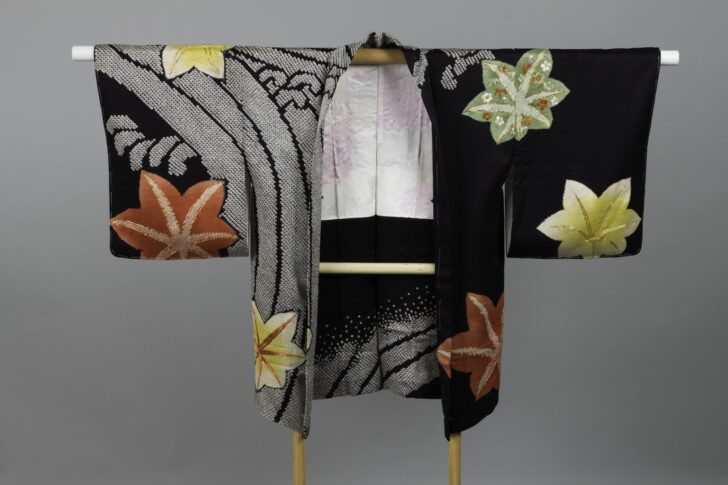Haori
Japanese

Description
Haori
Japan, Showa period (1926–89)
Mid- to late–20th century
Silk
Gift of Mrs. Kazuko Miyake, 2016/2.74
Obi
Japan, Showa period (1926–89)
Mid- to late–20th century
Silk
Gift of Mrs. Kazuko Miyake, 2016/2.58
The striking design of this haori and obi are inspired by the Rimpa
School, an artistic tradition known for its bold use of color, motifs
abstracted from nature, and asymmetrical compositions. A haori is a
traditional Japanese hip or thigh length jacket with elongated sleeves,
worn over a kimono. Originally part of a man’s formal attire, in the
nineteenth century, female entertainers in Edo (modern Tokyo) adopted
it as a cloak for outdoor wear in mild weather. By the end of the century,
married women of the upper class had adopted black crepe silk haori
with family crests for formal, public occasions. For much of the twentieth
century, the haori has been the standard outerwear for a woman who
dresses in a kimono outside the home.
The obi is made of textiles developed in the Nishijin area of Kyoto, which
have dominated the market for high-quality woven textiles in Japan since
the fifteenth century. The production of Nishijin textiles is complex
and specialized in five main areas—designing and creating patterns,
producing silk threads, producing tools (including weaving machines),
weaving, and final sewing—each executed in a different workshop.
Summer 2022 Gallery Rotation
Subject Matter:
Rinzu is a pre-made white, blank thin silk fabric that contains textured interwoven designs onto which dye is applied for patterning and design.
Shibori is labor intensive dying technique in which hundreds of hours are spent tying miniscule sections of the fabric before immersing it in dye, leaving the tied parts white. Shibori textiles are very expensive due to the time and skills required to produce them.
The Haori is a traditional Japanese hip or thigh-length jacket with elongated sleeves that is worn over the kimono. The Haori typically includes an interior lining with a design that is otherwise hidden from view when worn.The haori was originally part of a man’s formal attire, but in the nineteenth century, female entertainers in Edo (modern Tokyo) adopted it as a cloak for outdoor wear in mild weather. By the end of the century, married women of the upper class adopted black crepe silk haori with family crests for formal, public occasions. For much of the twentieth century, the haori has been the standard outerwear for a woman who dresses in a kimono outside the home.
Physical Description:
Black rinzu haori with interwoven wave motifs with white shibori Oonami (large wave) motifs with dyed shibori light green, maroon, and yellow autumnal leaves with gold embroidery and miniature bamboo, plum blossom, dandelion, and chrysanthemum motifs with light pink and white peony lining.
Usage Rights:
If you are interested in using an image for a publication, please visit https://umma.umich.edu/request-image/ for more information and to fill out the online Image Rights and Reproductions Request Form.